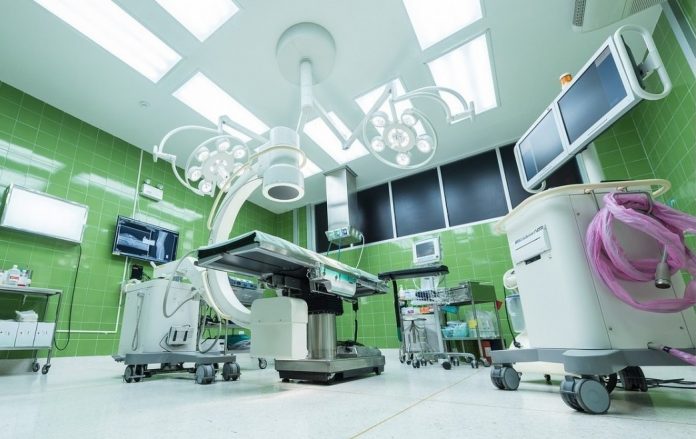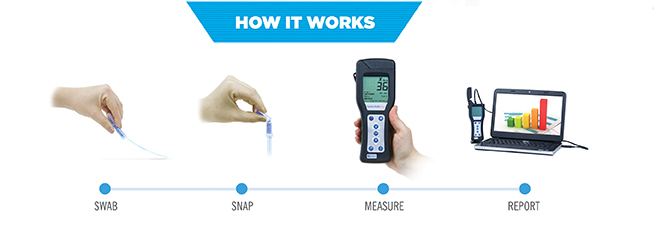An ATP cleaning verification system can help ensure cleaning is thorough and effective, saving money and lives in healthcare settings
The financial impact of poor cleaning is huge, yet the delivery of this vital underpinning service is not measured at all. By contrast, in almost all other aspects of healthcare, a multitude of diagnostic tests are performed to monitor and diagnose the conditions to aide recovery, prevent infections and cure the problem. There are many cost effective benefits to be gained across the hospital from the adoption of simple objective measurement of cleaning efficiency and delivery of service.
Cleaning is a fundamental preventative principle of good hygiene, as promoted by campaigns such as WHO’s ‘Clean Your Hands’ initiative, but it does not stop there. The recognition that healthcare associated infections (HCAIs) are preventable has driven many different interventions that have resulted in a decrease in MSRA and C. Diff infections since 2008. Over 15 years ago it was proven that effective cleaning had a cost benefit of £56,000 per ward, per annum (excluding the cost of lost bed days and additional domestic and maintenance staff). The concern for increasing antimicrobial resistance means that cleaning practices need to be more vigilant and effective to prevent the spread of infection.
Cleaning costs the NHS £725m per annum, but research shows that only 40% of hospital cleaning policies are delivered in practice, resulting in the potential wastage of more than £400m. The NHS Productivity Review 2016 showed that a small improvement in cleaning practices alone would save £93m.
The cost of failure is high. A single infection is estimated to cost £5,000-£10,000. The National Patient Safety Association states that there are more than 200,000 slip injuries per annum, resulting in 26 deaths. It estimates that the average trust spends £92,000 per annum on these types of injuries.
Most hospitals rely on a subjective visual assessment of cleanliness, which is not fit for purpose and only detects gross lapses of practice. Visual assessment gives a misleading over-estimate of cleaning that undermines infection control strategies.
The National Institute for Health Research (NIHR) recognises that the NHS places greater reliance on visual assessment of surface cleanliness. However, reliance on observational evidence in judging cleaning efficacy is subjective and may be of questionable validity. The use of ATP bioluminescence can provide this, giving an instant indication of total surface contamination and importantly, an objective assessment of cleanliness. ATP detects invisible contamination and tells us that the surface has been cleaned.
The complex design of endoscopes makes them very hard to clean and studies have shown that more than 30% are not adequately cleaned. In sterile services, the cleaning process is measured by an inadequate protein test where a single-minded focus on the potential unrealised hazards from prion proteins is driving an impractical, expensive, in situ, non-specific protein detection method; in total disregard for the more immediate and real biological hazards, that are quicker and easier to measure, as well as giving a broader reassurance.
ATP bioluminescence lighting the way
The use of ATP bioluminescence for cleaning verification is well established and comes highly recommended in support of the fight against HCAIs. The test is also recognised by the CDC in the USA and is written into a standard for cleaning in Denmark and Sweden. The test is simple and easy to use giving a numerical result in 15 seconds. ATP bioluminescence is a simple rapid method for measuring organic soil. It requires a small handheld instrument and an all-in-one sample collection and testing device.
Earlier adopters, such as North Tees and Hartlepool NHS Foundation Trust have shown a consistent and marked improvement in cleanliness and reductions in infection rates since its introduction in 2008. The results have shown a more than 20% improvement in pass rates and a large reduction in fail scores to fewer than 5%, with a corresponding decrease of 35% in C. difficile cases, as well as a 39% reduction in infections per 10,000 occupied bed days. Monitoring officers, independent from nursing and environmental services staff, are assigned to act as project champions for individual facilities, reporting to departmental managers, wherever poor cleaning was discovered and where corrective action is required. Monthly reports are circulated for cross-functional team meetings of nursing, facilities and infection control staff. This allows for open discussions on all cleaning and maintenance related issues and stimulates actions for improvement.
The benefits of the ATP cleaning verification system include a dramatic improvement in hospital cleanliness, optimised cleaning performance and personnel training, increased productivity commitment and moral of cleaning staff and reduced infections rates.
Southport and Ormskirk Hospital NHS Trust have been using the ATP technology for more than 5 years, for several applications and departments from medical equipment library, ITU, IP&U, domestic services, planned care, catering and operating theatres. It is also used for hand hygiene training and compliance monitoring. Andrew Chambers explained: “We also use Hygiena ATP monitoring when we may have had an incidence of VRE, for example. After a clean, the area might look clean but a number of spot ATP tests could show that the area is, in fact, not clean.”
“ATP gives you a clean hospital,” said Val Hulme, Team Leader Domestic Services. “When you’re doing a deep clean the staff know they are going to be tested, but they do everything to a very high standard now. ATP has helped us to achieve that. When you have a number – like the ATP machine gives you – it’s more objective than subjective. You can’t argue with it. ATP makes the staff competitive. They all want to score five or below, or ideally zero.”
Regular objective monitoring of cleaning increases compliance with cleaning policies from 40% to 82%. This decreases contamination levels, reduces infection rates, maximises the use and value of existing resources thus saving time, money and lives.
Martin Easter
General Manager
Tel: +44 1923 818821
Please note: this is a commercial profile












